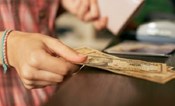If you are one of the people packing up for a summer vacation or just leaving for a weekend getaway, you might want to consider ways to stretch your budget to extend your fun at your destination. Although stopping for beverages and food along the way is enjoyable, your dining options can take a bite out of your budget.
Trust me. Next month, you won’t remember that you had a $3 energy drink. In fact, if I were to “energize” my entire family of five, I would be spending $15 on beverages that might “wire” them with caffeine. In a couple hours, they would be thirsty again.
The other day, my student intern looked up some price-comparison information for beverages. She went to a convenience store and priced a few items, and then she looked up pricing information at a local grocery store. While this was not a scientific study, this activity showed how much you can save on beverages if you avoid buying individual containers.
For example, a 16-ounce bottle of a popular energy drink was priced at $2.79, and a 20-ounce bottle of soda pop was $1.50 at this particular store. At a grocery store, we could have purchased a 24 pack of bottled water for $5.98, or about 25 cents per bottle.
If you purchased 24 individual bottles of energy drink or soda, you would have spent about $67 or $36, respectively, instead of the $5.98 for the same amount of bottled water.
On the other hand, if you opted for bottled water instead of bottled “energy,” you would have room in your budget to purchase plenty of healthful, satisfying foods.
Be aware that many convenience stores also sell “packs” of water and other beverages, so be sure to check that option. Even better: Tap water is free if you bring your own reusable container.
Food is another potentially costly option as you travel.
When you visit a new city, be sure to check in at the visitors bureau or other information center. It may have booklets with restaurant coupons that offer discounts on meals.
Many hotels have rooms with refrigerators or even kitchenettes with microwave ovens where simple meals or snacks can be prepared. Bring some food with you in an ice chest (cheese, yogurt, etc.), along with granola bars, whole-grain crackers, and whole fruit or fruit cups. Dried fruit and nuts also make satisfying snacks.
Many hotels offer complimentary hot breakfasts, which can extend your food dollars considerably. If you do not have a breakfast provided, consider having a snack in your room in the morning, then having a late-morning brunch in place of breakfast and lunch. Or, make lunch your main meal of the day. Lunch menus usually are priced lower than dinner menus. Consider sharing an entrée because restaurant meals often are large.
At restaurants, opt for ice water instead of sodas or other beverages. Beverages can add $10 to $15 to the dining tab for a family. If you like specialty drinks, you can multiply that cost.
While you are exploring new places, make your dining adventures an experience that doesn’t necessarily break the bank. Consider splurging for one meal of the day, and make your dining experience memorable by trying some of the local specialty restaurants. Your hotel concierge or a friendly native of the city may help guide you to a good local choice.
For example, when we traveled to Wisconsin last year, we participated in a “fish boil.” I was a little skeptical about what to expect when someone described it. The chef prepares a mixture of fish, potatoes and other vegetables in a boiling pot of water outdoors. At the end of the cooking time, he threw kerosene on the fire, causing the water to boil over the edges of the pot and extinguish the fire.
Although the dining adventure was not necessarily economical, my kids still talk about the explosion and ball of flames followed by a delicious meal. They happily ate their veggies. And no, I haven’t tried that preparation technique at home.
You do not necessarily have to travel far to have a fun food experience. When I was young, we enjoyed homemade lemonade, sandwiches and salads taken along with us to picnics at a park.
Here’s a lemonade recipe with several variations courtesy of Cornell Cooperative Extension.
Homemade Lemonade
1 lemon
3/4 c. water
2 Tbsp. sugar
Cut lemon in half crosswise. Place lemon half on juicer and twist to squeeze out the juice. Pour juice into glass, removing any seeds. Add about 3/4 cup of water. Add sugar, stirring to mix ingredients.
Variations:
- Lemon-limeade: For each glass, squeeze one-half of a lemon and one-half of a lime.
- Lemon-orangeade: For each class, squeeze one-half of a lemon and one-half of an orange.
- In place of the sugar, use 1/4 c. apple juice concentrate.
- Use 1/4 c. seltzer water and 1/2 c. water.
Makes one serving (1 cup) of lemonade. One serving has 60 calories, 0 grams (g) of fat, 17 g of carbohydrate and 10 milligrams of sodium.
Source: North Dakota State University







